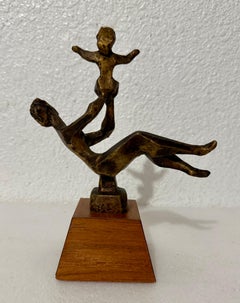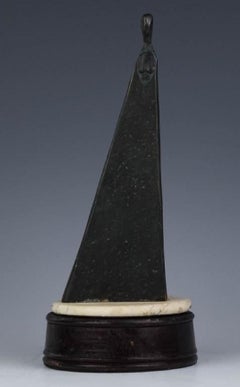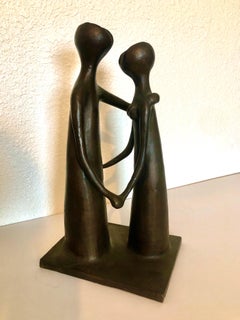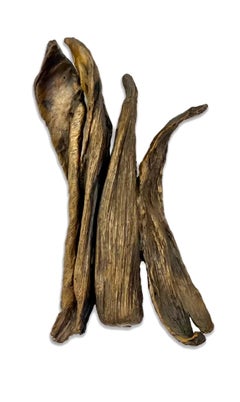Want more images or videos?
Request additional images or videos from the seller
1 of 8
Prince Monyo Simon Mihailescu-NasturelPrince Monyo Fiddler on the Roof Bronze Shtetl Sculpture Rare Judaica
Price:$1,750
$3,600List Price
About the Item
- Creator:Prince Monyo Simon Mihailescu-Nasturel (Romanian)
- Dimensions:Height: 24 in (60.96 cm)Width: 6.5 in (16.51 cm)Depth: 6 in (15.24 cm)
- Medium:
- Movement & Style:
- Period:
- Condition:
- Gallery Location:Surfside, FL
- Reference Number:1stDibs: LU382999253
About the Seller
4.9
Platinum Seller
Premium sellers with a 4.7+ rating and 24-hour response times
Established in 1995
1stDibs seller since 2014
1,810 sales on 1stDibs
Typical response time: 1 hour
Authenticity Guarantee
In the unlikely event there’s an issue with an item’s authenticity, contact us within 1 year for a full refund. DetailsMoney-Back Guarantee
If your item is not as described, is damaged in transit, or does not arrive, contact us within 7 days for a full refund. Details24-Hour Cancellation
You have a 24-hour grace period in which to reconsider your purchase, with no questions asked.Vetted Professional Sellers
Our world-class sellers must adhere to strict standards for service and quality, maintaining the integrity of our listings.Price-Match Guarantee
If you find that a seller listed the same item for a lower price elsewhere, we’ll match it.Trusted Global Delivery
Our best-in-class carrier network provides specialized shipping options worldwide, including custom delivery.You May Also Like
Falling Man and Form
By Ernest Tino Trova
Located in Missouri, MO
Ernest Tino Trova
"Falling Man and Form" 1996
Brass and Bronze
14 x 4.5 x 4.5 inches
Signed and Numbered 1/1 (Unique)
Known for his Falling Man series in...
Category
1990s American Modern Figurative Sculptures
Materials
Brass, Bronze
The Mother - British Old Bronze Sculpture Dark Brown Patina Albert Toft Original
Located in Sofia, BG
"The Mother" is a bronze sculpture by the English professor of modeling and sculpture Albert Toft.
About the artwork
The bronze is covered with dark brown...
Category
Early 1900s Modern Figurative Sculptures
Materials
Bronze
$9,633
H 14.57 in W 7.49 in D 8.27 in
The Dancer - Sculpture by Giacomo Manzù - 1957
By Giacomo Manzú
Located in Roma, IT
The Dancer is a sculpture realized by Giacomo Manzù in 1957. Unique piece.
Exhibitions:
Manzù. L’Uomo e l’Artista, Palazzo Venezia, Roma 2002-2003
Manzù-Marino. Gli ultimi moderni,...
Category
1950s Modern Figurative Sculptures
Materials
Bronze
$289,004
H 5.71 in W 5.71 in D 35.44 in
Satiro - Original Bronze Sculpture by Giulio Aristide Sartorio
By Giulio Aristide Sartorio
Located in Roma, IT
Bronze head sculpture realized by Giulio Aristide Sartorio, an Italian painter, sculptor and film director from Rome.
Having attended the Rome Institute of Fine Arts, Sartorio presented a Symbolist work at the 1883 International Exposition of Rome. He made friendships with Nino Costa and Gabriele D’Annunzio, and associated with the painters and photographers of the Roman countryside.
His period of greatest renown came at the beginning of the century, when he produced decorative friezes for the 5th Esposizione Internazionale d’Arte of Venice (1903), the Mostra Nazionale of Fine Arts (Milan, Parco Sempione...
Category
Early 20th Century Modern Figurative Sculptures
Materials
Bronze
$30,104
H 9.06 in W 5.32 in D 5.91 in
Woman - Sculpture - Mid-20th Century
Located in Roma, IT
Balinese bronze sculpture of woman.
Placed on a wooden pedestal.
Excellent condition.
Category
Mid-20th Century Modern Figurative Sculptures
Materials
Bronze
Victory (La Vittoria) - Sculpture by Adolfo Wildt - 1990
By Adolfo Wildt
Located in Roma, IT
Second Edition of 6 copies plus 3 Artist’s Proofs, realized in 1990 after the famous homonymous sculpture realized by Wildt in 1918/19. Authorized by Wildt's heirs, from the original...
Category
1990s Modern Figurative Sculptures
Materials
Bronze
$11,439
H 5.52 in W 13 in D 16.15 in
Head of Man - Sculpture by Amedeo Bocchi - 1920
By Amedeo Bocchi
Located in Roma, IT
Head of Man is an artwork realized by Amedeo Bocchi in 1920 ca.
This little sculpture is made in gilded bronze with a brown/gold patina.
Signed and numbered on the right side. Edi...
Category
1920s Modern Figurative Sculptures
Materials
Bronze
$7,225
H 11.82 in W 7.49 in D 4.34 in
Acrobat Family - Bronze Sculpture by Arturo Martini - 1936
By Arturo Martini
Located in Roma, IT
Acrobat Family is an original artwork realized by Arturo Martini in 1936.
Bronze sculpture with wooden base.
Provenance: Pecci Blunt Collection.
Published in the general catalogue...
Category
1930s Modern Figurative Sculptures
Materials
Bronze
Price Upon Request
H 15.75 in W 13.39 in D 11.82 in
Vestal with Jug - Sculpture - Early 20th Century
Located in Roma, IT
Vestal with Jug is an original modern sculpture realized by an italian Artist of the early 20th Century.
Bronze sculpture and marble base.
Signature on the basement.
Decor your sp...
Category
Early 20th Century Modern Figurative Sculptures
Materials
Bronze
$1,143
H 17.33 in W 5.91 in D 5.91 in
Il Bernini - Sculpture by Ambrogio Borghi - 1884
Located in Roma, IT
The bronze proposed here was initially presented in November 1878 at the Competition for the Encouragement of Brera. It is therefore one of the first celebratory works of the sculptor Ambrogio Borghi...
Category
1880s Modern Figurative Sculptures
Materials
Bronze
$52,984
H 47.64 in W 14.18 in D 19.3 in
More From This Seller
View AllChaim Gross Mid Century Mod Bronze Sculpture Mother and Baby Playing WPA Artist
By Chaim Gross
Located in Surfside, FL
Chaim Gross (American, 1904-1991)
Cast bronze sculpture
Caring (or Mother and Child)
signed
Mounted on wooden plinth
Featuring a mother raising her child up in superb high relied i...
Category
Mid-20th Century American Modern Figurative Sculptures
Materials
Bronze
Sydney Kumalo Bronze Minimalist African Modernist Sculpture Figural Female Nude
Located in Surfside, FL
Sydney Kumalo. Features a bronze stylized female figural form sculpture fixed to a marble plinth and wood base. Bears signature on base. Measures 9 1/2" x 4 1/4". There is no edition number on the piece.
Sydney Kumalo (1935 - 1988) was born in Sophiatown, Johannesburg, on 13 April 1935. His was one of the families who had to move out of the "white" city to the South Western Townships, or Soweto. Raised in Diepkloof and educated at Madibane High School, he took with him from old Sophiatown the curious and diverse heritage of its heyday. Art classes in the Catholic school, "Sof' town" blues and jazz, the vibrant street culture and growing defiance of its population of various races who were gradually forced out into separate race-group areas. So it was that these various aspects of his early life created for Kumalo a cultural mix of a Zulu family related to the traditional royal house; city schooling, nascent township music and lingo; growing urbanised political defiance and the deep-rooted Zulu pride and respect for the legends and ancient stories of a tribal people. This mix of old and new cultures was reinforced when he began his studies at the Polly Street Art Centre in 1953 where he became a member of Cecil Skotnes group of serious artists who were encouraged to acquire professional skills. Skotnes introduced a basic training programme with modelling as a component, which marked the introduction of sculpting (in brick-clay) at Polly Street.
Kumalo was Skotnes’ assistant at Polly Street from 1957 to 1964, and having recognised his great talent as a sculptor, Skotnes encouraged him to become a professional artist.
After Kumalo’s very successful assistance with a commission to decorate the St Peter Claver church at Seeisoville near Kroonstad, with painting designs, sculpture and relief panels in 1957, Skotnes arranged for Kumalo to continue his art training by working in Edoardo Villa ’s studio from 1958 to 1960. Working with Villa, he received professional guidance and began to familiarize himself with the technical aspects of sculpting and bronze casting. In 1960 he became an instructor at the Polly Street Art Centre.
Kumalo started exhibiting his work with some of the leading commercial Johannesburg galleries in 1958, and had his first solo exhibition with the Egon Guenther Gallery in 1962. He was a leader of the generation who managed to leave behind the forms of African curios, reject the European-held paternalism which encouraged notions of "naive" and "tribal" African art, and yet still hold fast to the core of the old legends and spiritual values of his people. He introduced these subjects into his bronze sculptures and pastel drawings, evolving his own expressive, contemporary African "style".
Together with Skotnes, Villa, Cecily Sash and Giuseppe Cattaneo, Kumalo became part of the Amadlozi group in 1963. This was a group of artists promoted by the African art collector and gallery director Egon Guenther, and characterised by their exploration of an African idiom in their art. Elza Miles writes that Cecil Skotnes’ friendship with Egon Guenther had a seminal influence on the aspirant artists of Polly Street: “Guenther broadened their experience by introducing them to German Expressionism as well as the sculptural traditions of West and Central Africa. He familiarised them with the work of Ernst Barlach, Käthe Kollwitz, Gustav Seitz, Willi Baumeister and Rudolf Sharf.” It is therefore not surprising that some of Kumalo’s sculptures show an affinity with Barlach’s powerful expressionist works. Guenther organised for the Amadlozi group to hold exhibitions around Italy, in Rome, Venice, Milan and Florence, in both 1963 and 1964.
Kumalo’s career took off in the mid 1960s, with his regular participation in exhibitions in Johannesburg, London, New York and Europe. He also represented South Africa at the Venice Biennale in 1966, and in 1967 participated in the São Paulo Biennale.
EJ De Jager (1992) describes Kumalo’s sculpture as retaining much of the “canon and formal aesthetic qualities of classical African sculpture. His work contains the same monumentality and simplicity of form.” His main medium for modelling was terra cotta, which was then cast in bronze, always paying careful attention to the finish of both the model as well as the final cast. He began casting the pieces he modelled in clay or plaster into bronze at the Renzo Vignali Artistic Foundry in Pretoria North. He worked throughout his life with its owners, the Gamberini family, and enjoyed learning the technical aspects of the casting process, refining his surfaces according to what he learned would produce the best results in metal. De Jager further writes that Kumalo’s distinctive texturing of the bronze or terra cotta is reminiscent of traditional carving techniques of various African cultures. “In many respects Kumalo thus innovated a genuine contemporary or modern indigenous South African sculpture”. Kumalo came to admire the works of the Cubists, and of British sculptors Henry Moore and Lynn Chadwick. He became noted for adapting shapes from them into his own figures. The success of his use of the then current monumental simplicity and purely aesthetic abstractions of natural forms has been emulated by many South African sculptors since the 1970s.
He was in many ways the doyen of South African Black art. As such he was an important influence especially on younger African sculptors, by whom he is greatly revered. Through his teaching at Polly Street and at the Jubilee Centre, as well as through his personal example of integrity, dedication and ability, he inspired and guided students who in their own right became outstanding artists, for example, Ezrom Legae, Leonard Matsoso and Louis Maqhubela
From 1969 onward, he allied himself with Linda Givon, founder of The Goodman Gallery in Johannesburg, where he exhibited regularly until his death in December 1988. Working with Givon also perpetuated his associations with his many friends of strong principles. Skotnes, Villa, Legae and later such peers from the Polly Street era as Leonard Matsoso, Durant Sihlali and David Koloane have all exhibited at The Goodman Gallery. Kumalo, Legae, and later Fikile (Magadlela) and Dumile (Feni) were among the leading exponents of a new Afrocentric art...
Category
20th Century Modern Figurative Sculptures
Materials
Marble, Bronze
Israeli Bronze Sculpture Lovers Embrace Abstract Modernist Ein Hod Israel
By Gedalia Ben Zvi
Located in Surfside, FL
Bronze sculpture signed in Hebrew and numbered from small edition of 6
BIOGRAPHY
"I was born in Czechoslovakia in the year 1925, of traditional parents. I spent my youth partly in ...
Category
Mid-20th Century Modern Figurative Sculptures
Materials
Bronze
Cast Bronze Organic Husk Wall Mounted Abstract Textured Sculpture Seena Donneson
By Seena Donneson
Located in Surfside, FL
This is an abstract Flora based hand made, cast sculpture done by Seena Donneson an acclaimed woman artist.
A textured abstract bronze with deep, rich patina; The sculpture is signed...
Category
21st Century and Contemporary Modern Abstract Sculptures
Materials
Bronze
Cast Bronze Organic Husk Wall Mounted Abstract Textured Sculpture Seena Donneson
By Seena Donneson
Located in Surfside, FL
This is an abstract Flora based hand made, cast sculpture done by Seena Donneson an acclaimed woman artist.
A textured abstract bronze with deep, rich patina; The sculpture is signed...
Category
21st Century and Contemporary Modern Abstract Sculptures
Materials
Bronze
Bronze Sculpture Figure with Beast American Modernist Leonard Baskin Museum Art
By Leonard Baskin
Located in Surfside, FL
Leonard Baskin, American 1922-2000
Homage to the Un-American Activities Committee
Bronze relief sculpture plaque
This is not editioned, nor signed or numbered, on the piece but according to the catalog there was 12 or less.
A number of these are in museum and university art collections and one of them was exhibited at MoMA NY.
This was done to commemorate the communist witch hunts of the Mccarthy era. An important, historic piece.
Leonard Baskin (August 15, 1922 – June 3, 2000) was an American sculptor, illustrator, wood-engraver, printmaker, graphic artist, writer and teacher.
Baskin was born in New Brunswick, New Jersey. While he was a student at Yale University, he founded Gehenna Press, a small private press specializing in fine, small edition, book production. From 1953 until 1974, he taught printmaking and sculpture at Smith College in Northampton, Massachusetts. Subsequently Baskin also taught at Hampshire College in Amherst, Massachusetts.
He lived most of his life in the U.S., but spent nine years in Devon at Lurley Manor, Lurley, near Tiverton, close to his friend Ted Hughes, for whom he illustrated Crow. Sylvia Plath dedicated Sculpto to Leonard Baskin in her famous work, The Colossus and Other Poems (1960).
The Funeral Cortege (1997) bronze, Franklin Delano Roosevelt Memorial, Washington, D.C.
His public commissions include a bas relief for the Franklin Delano Roosevelt Memorial and a bronze statue of a seated figure, erected in 1994 for the Holocaust Memorial in Ann Arbor, Michigan.
His works are owned by many major museums including the Metropolitan Museum of Art, the Museum of Fine Arts, Boston, the Museum of Modern Art, the Art Institute of Chicago, the Boca Raton Museum of Art, the British Museum, the Honolulu Museum of Art, the Udinotti Museum of Figurative Art and the Vatican Museums. The archive of his signed work at the Gehenna Press was acquired by the Bodleian Library at Oxford, England, in 2009. The McMaster Museum of Art in Hamilton, Ontario owns over 200 of his works (some religious and biblical), most of which were donated by his brother Rabbi Bernard Baskin.
Contemporary Religious Imagery in American Art. Catalog for an exhibition held at the Ringling Museum of Art, March 1-31, 1974. Artists represented: David Aronson, Leonard Baskin, Max Beckmann, Hyman Bloom, Fernando Botero, Paul Cadmus, Marvin Cherney, Arthur G. Dove, Philip Evergood, Adolph Gottlieb, Jonah Kinigstein, Arman, Rico Lebrun, Jack Levine, Louise Nevelson, Barnett Newman, Abraham Rattner, Ben Shahn, Mark Tobey, Max Weber, William Zorach and others.In 1955, he was one of eleven New York artists featured in the opening exhibition at the Terrain Gallery, they showed many great artists, Chaim Koppelman, for many years, headed the gallery's Print Division; printmakers such as Will Barnet, Leonard Baskin, Robert Conover...
Category
1950s Modern Figurative Sculptures
Materials
Bronze
Recently Viewed
View AllMore Ways To Browse
Girl With Dove
Mr Freedom
Joseph Kirkpatrick
Julius Paul Junghanns
Jungblut Johann
Kate Rivers
Keith Haring Japan
Keith Haring Paris Review
La Rochelle Painting
Ladybug Painting
Lake Michigan Oil Painting
Lake Placid Poster
Landscapes With Purple Sky
Laporte Georges
Large Hunting Paintings
Lassen Print
Laurie Kersey
Le Coquelicot



